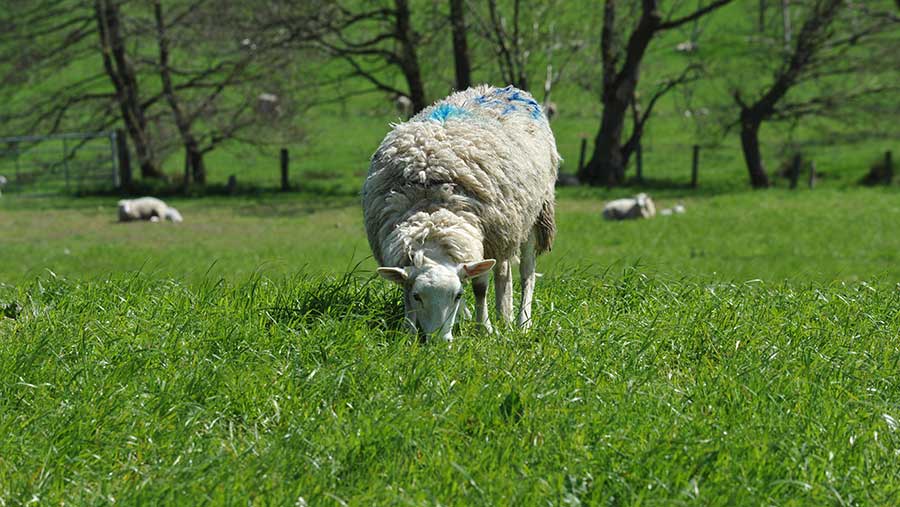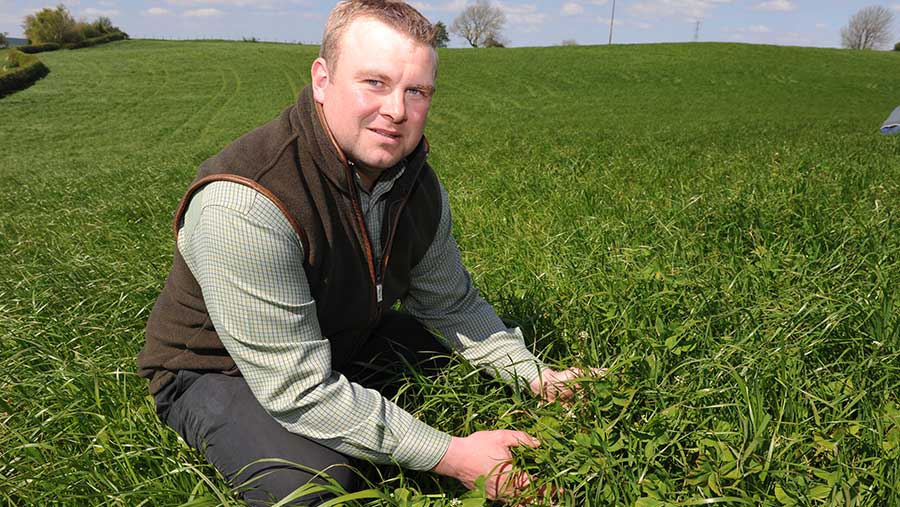Growing clover helps sheep farmer cut feed costs
 Aberfield grazing at Llyn Rhys © Debbie James/RBI
Aberfield grazing at Llyn Rhys © Debbie James/RBI Feeding clover to ewes pre-lambing has resulted in savings of £1.68 a head in bought-in feed as well as improving soil fertility while reducing the need for chemical inputs.
Pearce Hughes planted a 6-acre trial plot of balansa – an annual clover native to north-eastern Mediterranean regions – to establish how it performed in UK conditions.
Mr Hughes is an Innovis multiplier and runs a flock of 1,250 Lleyn, Aberfield, Abermax and Abervale ewes at Llyn Rhys near Wrexham, a Farming Connect Focus Site.
The seed, a variety called Fixation and bred in America for extra cold tolerance, was sown at the beginning of June 2016, with 5kg/ha of balansa and 22kg/ha of Italian ryegrass.
See also: Clover yields extra milk worth £630/ha, study shows
The crop was cut on 12 August and yielded 33 bales at 630kg/bale – the equivalent of 4t/ha. “It was at waist-level when we cut it,’’ says Mr Hughes.
Feeding
He fed the balansa silage to his twin- and triplet-bearing ewes in late February, five weeks before lambing.

Pearce Hughes with balansa and Italian ryegrass © Debbie James/RBI
The flock starts lambing on 25 March and an 18% protein concentrate is normally introduced five weeks beforehand. But the performance of the ewes on the balansa silage was so good that Mr Hughes delayed feeding by two weeks.
He estimates this resulted in savings of £1.68 a head in his twin-bearing ewes. “The quality of the silage was so good that it essentially replaced the cake. We probably could have held off feeding for another week or so but we didn’t want to risk it.
“We had been hoping the balansa silage would have achieved a protein level of 16% instead of 14.5%, but with a slightly earlier cutting date I am sure we could have achieved this.
“Our aim is to try to produce rocket fuel silage to feed the ewes before lambing to minimise the amount of concentrate we put into them.’’
Other benefits
But Mr Hughes doesn’t view balansa only as a means of reducing his purchased feed costs.
He says its nitrogen-fixing properties are improving soil fertility and reducing inputs of chemical fertiliser. A 5:24:24 fertiliser was applied at 246kg/ha at sowing followed by 123kg/ha of urea four weeks later.
Mr Hughes says he used 20% less bagged fertiliser on balansa compared with what he would have used on an Italian ryegrass ley.
Balansa is also an aggressive weed suppressant. “Nothing stood a chance against it, even the Italian ryegrass was struggling to keep up. With the likelihood of some weedkillers being withdrawn in the future this is definitely a consideration,’’ says Mr Hughes.
Spring-sown balansa doesn’t grow back after cutting, only autumn varieties do.
Independent grassland and forage specialist Charlie Morgan says with an autumn sowing it should to be capable of producing three cuts of silage and grazing for fattening lambs.
“The optimum time for sowing is mid- to late-autumn, because it allows the plant to establish before the winter and to develop a strong rooting system,’’ Mr Morgan explained.
“In the USA it can be cut later after flowering and will drop hard seeds that will regenerate for another two or three years. We need to learn if the UK climate conditions will allow for the same management and outcomes.’’
Bridging the feed gap
To bridge the gap left by the balansa, more balansa clover seed was stitched into the ley in half the field shortly after the silage was cut and berseem clover was stitched into the other half.
The yield of Italian ryegrass has been boosted by the decaying clover from the previous crop, releasing nitrogen into the soil.
The berseem was well established by the spring – it grew at an average of 31kg/DM/ha/day from 20 March. No fertiliser was applied last autumn and Mr Hughes applied only a single dressing of 23:4:13 fertiliser at a rate of 187kg/ha in early April.
Unlike some forages, balansa will do well in less than ideal soil pH conditions. “It will grow well at a pH of 5.7 to 5.8, although there are reports of farmers growing it successfully in America at pH levels as low as 4.8,’’ says Mr Morgan.
Benefits of growing multi-species to combat drought
Mr Morgan believes farmers must look at the options for growing novel plants if the UK is to experience drier conditions in the future.
“With such dry conditions in parts of America, a multitude of species are sown into one mix and grown to maximise biomass. These crops can stand 5-6ft high and after they have been cut they are grazed to optimise livestock potential under difficult conditions.
“Annual clovers are high yielding and they have drought tolerant characteristics so they could be considered among a range of options farmers have at their disposal if the UK is to experience a change in climatic conditions.”
They also provide organic matter to weak soils, aiding water retention and nutrient availability. Some of these species have significantly different rooting capabilities.
